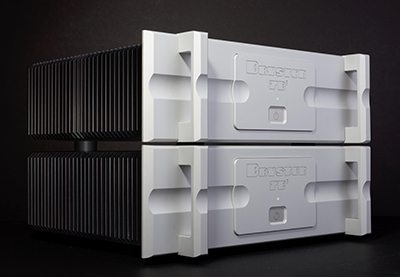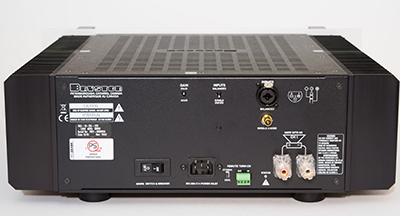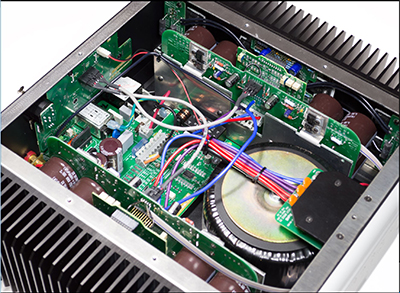 A
few months ago, when I first auditioned the new Bryston
4B-3 amplifier in my system, I was instantly taken
aback by what I heard and almost immediately speculated about
the sonic quality of a the new 7B-3s. Why? Well, because I have
had the 7B series 2 in-house for quite some time, and consider
myself intimately familiar with their sonic characteristics.
I wondered, no, I became somewhat anxious to hear the new Cubed
Series 3, 600-watt mono blocks. It took a while to get a pair
of the new ones, but after patiently waiting, I now have them
— connected and playing for about three weeks. A
few months ago, when I first auditioned the new Bryston
4B-3 amplifier in my system, I was instantly taken
aback by what I heard and almost immediately speculated about
the sonic quality of a the new 7B-3s. Why? Well, because I have
had the 7B series 2 in-house for quite some time, and consider
myself intimately familiar with their sonic characteristics.
I wondered, no, I became somewhat anxious to hear the new Cubed
Series 3, 600-watt mono blocks. It took a while to get a pair
of the new ones, but after patiently waiting, I now have them
— connected and playing for about three weeks.
Well, this is likely the fifth generation of the 7B model
I have auditioned and reviewed over the past couple of decades
and I expected them to sound at least similar to the previous
models I had in-house for a few years. I recall how, over
the years and model changes, Bryston’s amps have improved
steadily, but maintained a good part of their sonic personality/signature
— so they should indeed sound similar. They don't. In
fact, I didn't think it possible for two —actually four
— amplifiers from the same company to sound quite different!
These are very powerful solid-state amplifiers with excellent
build quality and with phenomenal specifications. They are
single channel amplifiers, and I quote — “virtually
perfect from overload on any type of loudspeaker”. Each
amp will put out over 600 watts into an 8-ohm load, (900w
into 4 ohms). They are equipped with single-ended (RCA) or
balanced (XLR) inputs, an active low distortion buffer and
selectable gain at 23 or 29dB. These specs are complement
by regulated, beefy power supplies to all voltage gain stages.
Harmonic distortion is quoted as 0.005% (from 20 to 20kHz);
noise below full output is -113 single ended and -116 balanced;
slew rate is 60 ms; damping factor is>300 at 20Hz. All
this may be meaningful to the technically savvy, but for me
they are but one part — a guide perhaps — because
I respect and accept scientific testing and specifications
where results show to correlate with what I hear. I hold that
science is not yet able to accurately evaluate all parameters
of sound.
Anyway, here is on of the most interesting parts of the technology
used in the Cubed Series designs. All incorporate a new circuit
design of the input stage — the "Salomie"
input stage, named after its designer and patented by Bryston.
Bryston states that this new input stage is more linear than
that of any amp they had produced before this series. Among
this new circuit’s attribute is a lower noise floor
which may be responsible for the amplifiers’ knack to
extract musical subtleties, not heard in many other SS design,
of which I know. The Cubed 7Bs are built like proverbial battleships
and boast the kind of attention to detail that makes most
high-end audio equipment outrageously expensive. That is,
of course, until we consider that most Bryston amps are still
operating 20 years after other real high-end phile equipment
has surrendered to terminal parts disorder.
For a lot more information simply click on http://www.bryston.com/products/power_amps/4B-3.html
THE SET-UP
 I
used a Wyetech Labs Ruby preamplifier, because I value its
neutral sonic disposition, which allows the amps and source
components to work at their best. A Bryston DAC and Digital
player were the source components, though I also used a Magnum
tuner to warm up the system. Cables were from Nordost and
included the TYR 2speaker cables and the Norse interconnects
as well as power cords. I
used a Wyetech Labs Ruby preamplifier, because I value its
neutral sonic disposition, which allows the amps and source
components to work at their best. A Bryston DAC and Digital
player were the source components, though I also used a Magnum
tuner to warm up the system. Cables were from Nordost and
included the TYR 2speaker cables and the Norse interconnects
as well as power cords.
My permanent loudspeakers are from Leo Lewis of Ethera Vitae
fame, and I have used these off and on for a couple of decades;
found them sonically refined and especially revealing (used
them almost every time when reviewing cables). As of the last
10 years, or so, I have used and compared them to much high
priced speakers (up to $20k), but have yet to find some that
will outperform them in all but the lowest bass. My listening
material is what I favour — the classical, including
large orchestral works, the jazz and the blues — have
a mean collection of well-mastered music.
THE SOUND
The 7B-3 are only the second solid-state amplifiers whose
extreme high frequencies can be favourably compared with the
best I have heard from tube amps, the other being the recently
auditioned, German-made T+ A. However, both of these SS amps
haven’t quite the somewhat embellished sweetness of
the best tube amps and are, instead, on the (more realistic)
drier side. The 7Bs haven’t a pinch of roughness or
glare in the high end, making them some of the smoothest-sounding
high-powered amplifiers that also boast plenty of dynamics.
Few, if any, amps will surpass them in terms of completely
unstrained openness and musicality. I daresay that these amplifiers
rank in the top category of the most neutral-sounding power
amps of which I know.
The highs and midrange segments of the frequency spectrum
are neither forward sounding like so many SS designs, nor
recessed like many tube amplifiers. They are not quite as
refined as one or two extremely high-end amplifiers, but then
again they don’t cost like them. The midrange —
from about 160 to 1400 Hz — is an important part of
music but must blend inaudibly with the range for the mid
highs. That is from about 2,000 to 5,000 Hz — and this
is where the Brystons perform almost perfectly, introducing
delicate texturing along with harmonics and this quality may
well be the reason why the system involved me with its ease
of listening throughout all of my tests.
Detail and resolution of delicate musical nuances are excellent,
while the soundstage width is very well rendered with depth
and perspective well presented. Imaging — the representation
of multi-dimensionality on a sound stage is not merely good,
it is superb and outperforms Bryston’s most recent predecessor
I had in house earlier — and that isn’t easy.
 Bass is excellent: deep, tight, and very well controlled,
but not quite as resolute as that from the older 7Bs. This
is not to say that the older version will do a better job
of reproducing low end on all loudspeakers. The new 7Bs will
likely do best with full-range loudspeakers that can manage
low frequencies down to 30Hz, no matter what efficiency rating.
My own Ethera Vitae reach down to 42Hz, but did wonderful
things below that point, probably benefiting from the amplifiers’
capability to deliver more than sufficient harmonics. In other
words, I didn’t miss bass, even when I played back music
from pipe organ recordings.
Bass is excellent: deep, tight, and very well controlled,
but not quite as resolute as that from the older 7Bs. This
is not to say that the older version will do a better job
of reproducing low end on all loudspeakers. The new 7Bs will
likely do best with full-range loudspeakers that can manage
low frequencies down to 30Hz, no matter what efficiency rating.
My own Ethera Vitae reach down to 42Hz, but did wonderful
things below that point, probably benefiting from the amplifiers’
capability to deliver more than sufficient harmonics. In other
words, I didn’t miss bass, even when I played back music
from pipe organ recordings.
CONCLUSION
I should tell you that I am not a SS or a vacuum tube advocate
and enjoy both technologies — I like the transparency,
precision and control of good solid-state amps, but quite
understand and often enjoy the euphonic elements and musicality
of well-designed tubed components.
Overall, the 7B-3s are probably as delightful-sounding as
any amps I've auditioned. They are completely without a familiar
sonic signature, yet immensely melodious and transparent,
and absolutely effortless in reproducing the kind of dynamic
range one may get at live performances of large orchestral
music.
The improvements to the amplifiers’ sound quality are
not subtle, and I regard them as delicate sonic enhancements
noticeable across all performance attributes such as highs,
mids, lows, imaging, focus, dynamics — well, I guess,
covering pretty well all the elements we in the business use
to explain the unexplainable with phile jargon— the
sound of things audio.
Here, then, is an amplifier that can hold its own, overall,
with anything else in its and higher price class; it will
work best with speakers that are neutral through the mid-range,
well extended and with smooth, detailed high frequency characteristics.
It’s my guess that the 7B-3s will handle all difficult
speaker loads as they can put out as much as 650 watts into
8 ohms, double that into 4 ohms. Those of you who are questioning
the need for this awesome power need to remember that there
really isn’t an amp with too much power; same as there
isn’t an amp with too much fidelity. The Cubed
7Bs sound better than any low-powered SS amplifier
I have ever heard, even at low listening levels.
These amplifiers may not be the world’s best, but they
are at the very least world-class amplifiers, better than
Bryston’s preceding amplifiers, as well as many of their
competition. The may not be inexpensive, but they do cost
a lot less than what hi-end audiophiles have been paying for
amplifiers that may not be anywhere as good. |